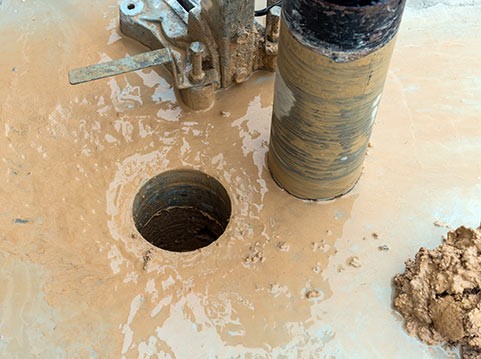Concrete scanning is the process of inspecting concrete structures to measure slab thickness, locate rebars, PT cables, conduits, and voids, and perform structural analysis. And concrete core drilling is the process of making precise circular holes and openings in the concrete structure for utility installation applications and other operations.
A core drilling system is used to cut the concrete. But before a structure is drilled, concrete scanning is used to determine the location of the utilities. GPR, or Ground Penetrating radar, is used for non-destructive concrete scanning. Have a look at the key points that specify the role of concrete scanning in core drilling.
Locate Rebars
Rebars are important structural components. Accidentally cutting the rebars may result in severe structural damage and sometimes even result in collapse. GPR scanning helps you determine the exact location of the rebars and prevent accidents.
Prevent utility damage
Utility lines run beneath the concrete surface. You cannot predict their location from the surface, and drilling at the wrong location may end up damaging the utility lines. For example, if you accidentally cut the electric lines, it may result in a power outage, costly repairs, and electrocution of the workers. Or if you damage the plumbing lines, it can result in major water leaks, which are costly to repair and cause inconvenience. GPR Scanning locates the utility and other subsurface features.
Locate voids
Voids in the concrete structure can occur due to a variety of reasons. Drilling air voids or weak areas in the concrete walls, slabs, and columns may put the structure's stability at risk. This can put the lives of the workers at risk. Ground-penetrating radar can avert accidents by thoroughly inspecting concrete structures. It can locate voids and hollow areas.
Where to get concrete scanning?
You can partner with Concrete Insight for concrete scanning and concrete core drilling. Concrete Insight uses the best ground-penetrating radar systems to provide quick and accurate results. We use GSSI Structure Scan Pro SIR400, which can be used to accurately detect:
●
Metal
●
Plastic
●
PVC
●
Concrete
●
Natural materials
●
Air pockets or voids
● Geological features and more
And for concrete coring, Concrete Insight uses advanced core bore coring systems for creating precise circular cores in the concrete structure. Our advanced drilling tool allows us to do the work quickly. We are the best core drilling company in Maryland which can do concrete coring/drilling from 1″ to 60″ in diameter for testing or running conduits through walls, slabs, and columns.
We can create openings for the following utility installation applications:
●
Plumbing
●
Electric cables
●
Fiber optic cables
●
HVAC
●
Manholes and more
Our team of talented concrete
coring technicians has 25+ years of experience in core drilling. Visit our
website to learn more.









